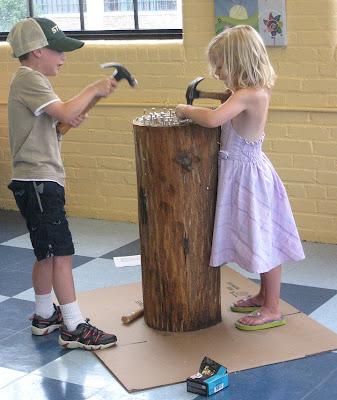Get Real!
By Megan Fischer, Providence Children’s Museum
Not long ago, I heard a story on the radio about kids spending their time playing Wii soccer. And I thought, what about real soccer? Outdoors, with real balls? And real kids? And then I thought about kids playing Guitar Hero instead of real instruments. And the fact that, according to the Alliance for Childhood, the average elementary-age child in the United States spends four to six hours per day in front of screens, in the form of television, computers, video games and other virtual realities – and less than half an hour outdoors.
Which led me to a moment from the PBS documentary Where Do the Children Play? in which Last Child in the Woods author Richard Louv explains that many children today “see nature as an abstraction” and that they’ve grown accustomed to “life wrapped in plastic” – removed from what’s real. He gives an example of kids seeing meat packaged in cellophane and styrofoam but not understanding that it has a real source, that it originates from somewhere other than supermarket shelves.
There are many concerns about screen-time impacting kids’ physical activity and opportunities for social development. But I also wonder about the implications of the distance from authenticity. What are they losing by not having real, tangible, even messy experiences?
As a kid, I loved climbing my favorite tree – stretching, reaching, pulling myself up, feeling the scratchiness of the bark against my skin and the patchy light filtering through the leaves to warm my face. My sister and I took off on adventures around our neighborhood, digging holes, building forts, picking flowers – things that were important to us because they were real, and because we were connecting with the world around us in the process.
Digging in, getting physical, getting messy – it’s important for all of us, kids and adults alike, to have real, hands-on experiences that connect us to our surroundings, both indoors and outdoors, in a deeper, more meaningful way. Not to mention the developmental benefits to kids of physically navigating their world – building motor skills, coordination, problem solving, and a sense of space and relationships.
Places like museums and nature centers, parks and zoos are valuable spaces for real, authentic experiences. One of our favorite stories at the Children’s Museum is of a 6-year-old girl actively playing in Water Ways, pumping hard to raise the water to spill over the top of a fountain, and then looking up in wonder: “I didn’t know water was heavy!” This type of real-world, hands-on tinkering in childhood fosters curiosity, helps kids make connections, and leads to adults who are more creative, more innovative and better problem-solvers. What a loss for our society if we don’t make space for exploring what’s real.
Let’s all make room for a reality check. This fall, get your kids outside, go for a hike or nature walk and examine leaves, turn over stones, and splash in streams. Take your family apple picking to encourage a deeper connection to one of our food sources – and have your kids join you in the kitchen to discover the fun of making real apple pie. Turn off the TV and video games and take in a live musical performance – let the joy and wonder of real people playing real instruments wash over you. Simple things like this can help all of us develop or rediscover a sense of wonder and appreciation for our world. For real!

No comments:
Post a Comment